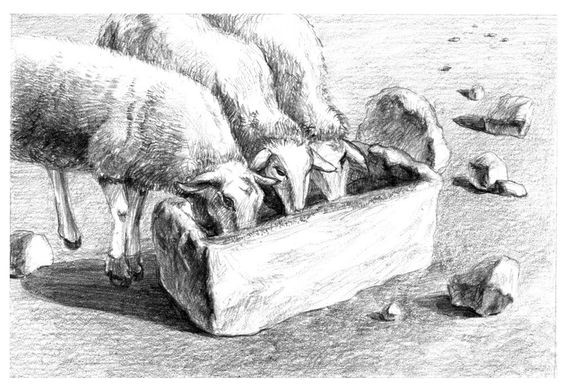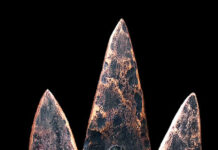A Search for Lodgings
“And so it was, that, while they were there, the days were accomplished that she should be delivered. And she brought forth her firstborn son, and wrapped him in swaddling clothes, and laid him in a manger; because there was no room for them in the inn.” (Luke 2:6-7.)

No room in the inn. If, as we believe, it was April and not December, then it was very likely Passover season in Jerusalem. This could explain the reason Joseph took Mary on the rigorous, sixty-mile journey to Judea when she was in the final month of her pregnancy. The Roman “taxing” mentioned by Luke was more accurately a census or enrollment. Each family head had to register and give an accounting of their property so that taxes could be levied. But while there was considerable flexibility in timing allowed to meet this requirement, if it was Passover season, that would allow them to meet two responsibilities. The Mosaic Law required that every adult male bring his sacrifices before the Lord (i.e., to the temple) each year at Passover. (See Ex. 23:14-19.) So by choosing this time of year, Joseph could fulfill both requirements.
Today we can hardly conceive of the magnitude of this most important of all Jewish festivals. From all over the empire, Jews returned to their homeland at Passover. Though determining exactly how large Jerusalem was during this period is difficult, a fairly accurate guess would place the population between one and two hundred thousand. Josephus tells us that during Passover “innumerable multitudes came thither [to Jerusalem] out of the country.” In another place, he was even more specific. Because the Paschal lamb had to be totally consumed by the family in the ritual meal, tradition stated that no fewer than ten and no more than twenty could gather for each lamb sacrificed. (See Ex. 12:10.) Josephus tells us that during one Passover of his time (about A.D. 70, 256,500 lambs were sacrificed. Even using the more conservative figure of ten, that still means the population of Jerusalem at Passover had swollen by more than 1000 percent to the staggering number of nearly three million people.

The throngs must have been incredible, the facilities throughout the city taxed beyond belief. And with Bethlehem only six miles south of Jerusalem, no wonder there was no room at the inn. Luke probably could have said with equal accuracy, “There was no room anywhere.”
Often in the art and literature surrounding the Christmas story, the unknown, unnamed innkeeper of the scriptural account is viewed as selfish and uncaring, an insensitive oaf unmoved by the plight of a woman heavy with child. This may make for interesting art and literature, but it is not justified by the scriptural record. In the first place, the “inns” of the Middle East were not quaint and homey little buildings with thatched roofs and latticed windows from which warm lamplight beckoned the weary traveler. The inns of the Holy Land were typically large, fortress-like buildings, built around a spacious open square. Called khans or caravanserai, they provided stopping places for the caravans of the ancient world.
Just as modern hotels and motels must provide parking for automobiles, so did a caravanserai have to provide a place where the donkeys, camels, and other animals could be safely cared for. Inside the khan, which was usually of two-story construction, all the “rooms” faced the courtyard. They were typically arched, open antechambers facing out onto the square. Here the traveler could build a small fire or sleep within clear view of his animals and goods. “In these hostelries, bazaars and markets were held, animals killed and meat sold, also wine and cider; so that they were a much more public place of resort than might at first be imagined.”
Even if there had been room at the inn, a caravanserai was hardly the ideal place for a woman in labor. Perhaps the innkeeper, moved with compassion at Mary’s plight and knowing of her need and desire for privacy, offered them his stable. Perhaps Joseph found the place on his own. The scriptures do not say. But one thing is very probable, and this contradicts another popular misconception. The birth likely did not take place in a wooden shed with pitched roof as is so commonly depicted in nativity scenes around the world. LDS Living

“tower of the flock” in Israel.
Micah 4:8 – The “Tower of the flock” is where the King will come.
Micah 4:8 says that the Messiah’s birth at Migdal Eder, the tower of the flock, is evidence that Jesus will one day come back to Jerusalem and set up his kingdom. The tower of the flock, Migdal Eder, is at the edge of the Shepherd’s fields where Priestly Shepherd’s watched over their lambs that were to be sacrificed at the Temple about three miles away in Jerusalem. Therefore, the sacrificial lamb, Jesus Christ, had to be born at Migdal Eder.
In Bethlehem today stands the Church of the Nativity. Beneath the church is a large grotto or cave. In southern Judea, including the area around Bethlehem, limestone caves are common. Such caves provided natural shelter for the flocks and herds of ancient Israel. They were warm, safe from inclement weather, and could easily be blocked to keep the animals safe for the night. The tradition that this grotto was the stable of Luke’s account is very old and accepted by many scholars. President Harold B. Lee, then of the Council of the Twelve, visited this grotto in 1958 and confirmed that in his mind it was “a hallowed spot, . . . a sacred place.”
So there in the sheltered warmth of the cave, beneath the limestone hills of Bethlehem, He who was to become the Good Shepherd—not of the sheep that grazed the hills of Israel, but of the human flock—was born and cradled in a manger.

That seems almost beyond our comprehension. Here was Jesus—a member of the Godhead, the Firstborn of the Father, the Creator, Jehovah of the Old Testament—now leaving His divine and holy station; divesting Himself of all that glory and majesty and entering the body of a tiny infant; helpless, completely dependent on His mother and earthly father. That He should not come to the finest of earthly palaces and be swaddled in purple and showered with jewels but should come to a lowly stable is astonishing. Little wonder that the angel should say to Nephi, “Behold the condescension of God!” (1 Ne. 11:26.)
Announcement to the Shepherds
“And there were in the same country shepherds abiding in the field, keeping watch over their flock by night. And, lo, the angel of the Lord came upon them, and the glory of the Lord shone round about them: and they were sore afraid. And the angel said unto them, Fear not: for, behold, I bring you good tidings of great joy, which shall be to all people. For unto you is born this day in the city of David a Saviour, which is Christ the Lord. And this shall be a sign unto you; Ye shall find the babe wrapped in swaddling clothes, lying in a manger.” (Luke 2:8-12.)
One of these verses is frequently misquoted: “Keeping watch over their flocks by night.” But the verse does not say flocks, plural, but flock, singular. One scholar explained the significance: “There was near Bethlehem, on the road to Jerusalem, a tower known as Migdal Eder, or the watchtower of the flock. Here was the station where shepherds watched the flocks destined for sacrifice in the temple. . . . It was a settled conviction among the Jews that the Messiah was to be born in Bethlehem, and equally that he was to be revealed from Migdal Eder. The beautiful significance of the revelation of the infant Christ to shepherds watching the flocks destined for sacrifice needs no comment.” The flock mentioned in the scripture, then, apparently was the one used for temple sacrifices, and the shepherds thus had responsibility for the most important flock in the region.

Sometimes in translation the power of the original language is considerably lessened. While the words, in English, of the angel to the shepherds are beautiful and significant, we miss much of the electrifying impact the original words must have had on those men of Judea. Let us just examine two or three of the phrases as we assume they were given in Aramaic to the shepherds that night.
“In the city of David.” We have already seen that the Jews expected Bethlehem to be the birthplace of the Messiah. This in part stemmed directly from the prophet Micah, who centuries before had specified the place. (See Micah 5:2.)
“Is born a Savior.” The word that meant “Savior” was Yeshua. In the Greek New Testament that name was transliterated into Hee-ay- sous, or, in English, “Jesus.” When the angel announced to Joseph that Mary would bear a son, note what he said: “Thou shalt call his name Jesus [Yeshua]: for he shall save the people from their sins.” (Matt. 1:21, italics added.)

“Which is Christ.” Our English word Christ is derived directly from the Greek, Christos. It means “the anointed one.” Christos was a direct translation of the Hebrew word, Messhiach, which meant exactly the same thing—the anointed one. Messhiach is of course transliterated into English as “Messiah.”
“The Lord.” The simple title, “Lord,” is perhaps the most significant of all, yet we totally miss its importance in the translation. In the Old Testament the name of God was written with four Hebrew consonants: YHVH. Because they did not write vowels, there has been some debate as to its proper pronunciation. Modern scholars often write it as YAHVEH, but the King James translators wrote it as JEHOVAH.

The Jews of ancient times, however, viewed the name as being so sacred that it should not be pronounced out loud. Whenever they found it written, they would substitute the Hebrew word Adonai, meaning the Lord. The translators who produced the King James Version of the Old Testament honored that tradition of the Jews, and where they found the name YHVH, they wrote in (with very few exceptions) “the Lord.” However, adonai can also be used as a title of respect for men, such as in the phrase, “My lord, the king.” To distinguish between the two uses, the translators wrote Lord in small capital letters if it represented the name of deity, and regular upper and lower case letters if used normally. (See, for example, 2 Sam. 15:21, where both uses are found in the same verse.) The declaration of the angel to the shepherds obviously used Lord or Adonai in reference to deity; literally it could be translated Jehovah.
Now we begin to sense the impact of the angel’s words upon these shepherds. In essence, here is his pronouncement: “Unto you is born this day in the city prophesied to be the birthplace of the Messiah, Yeshua [or Jesus], the Savior, who is the Anointed One (the Messiah), and who is also Jehovah, the God of your fathers.”
“And they came with haste, and found Mary, and Joseph, and the babe lying in a manger. And when they had seen it, they made known abroad the saying which was told them concerning this child. And all they that heard it wondered at those things which were told them by the shepherds. But Mary kept all these things, and pondered them in her heart.” (Luke 2:16-19.) “The Birth of Jesus Christ Was on This Wise” by LDS Living
Where was the Birth Place of the Lord Jesus? by Cooper P Abrams III
| The Nativity scene we see so often is of Jesus being born in a stable that sheltered animals has always bothered me. I grew up in a small town in rural eastern North Carolina and I have seen a lot of stables. Even the best kept ones are dirty smelly places because they house animals. I have never been able to understand how such an unclean place where donkeys and other animals resided was where Mary gave birth to the Lord Jesus Christ. Several years ago, a pastor friend of mine sent me an article that gave biblical evidence that Jesus was not born in an animal stable behind an inn where donkeys and other animals were kept, but in a more appropriate place. The following is the result of my research. |
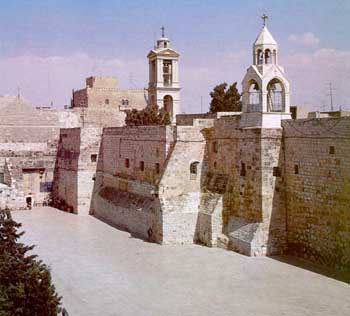
Tradition, not the Bible, says that Jesus’ birth place was in cave over which the Basilica of the Nativity was built in Bethlehem. Roman Emperor Constantine, built a Basilica1 over this cave in the 4th Century at the request of his mother, Helena. It was destroyed and the present basilica was built by Emperor Justinian in 530 AD. Origen of Alexandria (185 – 254 AD) wrote that it was generally accepted that Jesus was born in a cave at Bethlehem which could be visited in his day.

Clearly the city of Jesus’ birth was Bethlehem as Micah 5:2 prophesied and as the Gospels of Matthew, Luke and John confirm. (Matt. 2:1; Luke 2:4, 15; John 7:42) Luke proclaims the birth place as Bethlehem, “For unto you is born this day in the city of David a Saviour, which is Christ the Lord.” 1 Samuel 17:15, confirms Bethlehem as the City of David, “But David went and returned from Saul to feed his father’s sheep at Bethlehem.” But where in Bethlehem was Jesus born? The fact is that the New Testament does not mention the exact place in Bethlehem of where Jesus was born. Nowhere does the Bible record that Jesus was born in stable attended by donkeys, chickens, and cows as many nativity scenes present. In the past it was speculated that because there was no room for Joseph and Mary in the Inn, and that he was born in the stable behind the inn where the animals were kept. This conjecture is false and is a good example that shows us we should not apply speculation to God’s word. All the New Testament specifically says is that Jesus was laid in a manger in Bethlehem.
The popular conception that the word “manger” refers to a trough where animals were fed may be accurate. However, it could mean simply a stall. The Greek word which is translated in our English Bibles “manger” is Yatnh phat-ne (pronounced fat’-nay). The definition of the word is of a “stall” where animals are kept and in Luke 13:15 is translated as such. In the Septuagint (Greek translation of the Old Testament) the word means a stall or a crib (See Proverbs 14:4). The question is what kind of “stall” or manger is the New Testament referring to and what kind of animal was fed or housed there.

“But that manger in Bethlehem was not the wooden feed box we have come to imagine. It was not used for hay. And it was not made of poles or planks, lashed together with cords, as so often portrayed in Christmas art. The temporary cradle in which the newborn Jesus was laid was actually a manger cut from stone. How could we know all this, you may rightly ask? For over thirty years now I have worked in Israel as a researcher and field archaeologist, specializing in the material and cultural backgrounds of the biblical narratives. During all those years I have also taught New Testament courses at seminaries and for university religious studies programs. I’ve taught thousands of university students in Jerusalem and in the Galilee, and taken them over a hundred times for field study in every location from Nazareth to Bethlehem. Because I personally regard the New Testament gospel accounts as authentic and reliable, in my teaching I combine the biblical texts with critically valuable information provided by historical geography and contemporary archaeological research. The result is a realistic and more authentic understanding of scripture that goes beyond mere textual studies. It is a fusion which may properly be referred to as “contextual studies.”’
Stone Manger: The Untold Story of the First Christmas By Jeffrey R. Chadwick
Although the New Testament does not tell us where in Bethlehem Jesus was born, the Old Testament does. Micah 4:8 states, “And thou, O tower of the flock, the strong hold of the daughter of Zion, unto thee shall it come, even the first dominion; the kingdom shall come to the daughter of Jerusalem.” Thus the Old Testament clearly states that the Messiah would be born at the “tower of the flock” (Hebrew: Migdal Edar).
The phrase “tower of the flock” is the Hebrew phrase “Migdal Edar” [mig-dawl ay-der] and means a “watch tower of the flock”. In ancient times this was a military tower erected to view into the valley on the edge of Bethlehem to protect the city. Several of these military towers are recorded in the Old Testament (See Judges 8:71, 9:46, 9:51; 2 Kings 9:17, 18:8; Nehemiah 3:1) The tower at Bethlehem is first mentioned in Genesis 35:21, “And Israel journeyed, and spread his tent beyond the tower of Edar” (“tower of Edar” – Migdal Edar). After Jacob left Bethel he came to Edar (the tower) and there Rachel began hard labor and as she delivered Benjamin she died and was buried there in Ephratah which is Bethlehem” (Gen. 35:19). After burying Rachel, Jacob moved his flocks beyond the tower of Edar. This would pinpoint the location as being near to what is present day Bethlehem. Clearly, this establishes that Migdal Edar, “the tower of the flock” was in Bethlehem in Bible times.


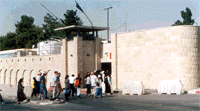
The oldest tradition, based upon Genesis 35:16-20; 48:7, points to a place one mile north of present day Bethlehem and 4 miles from Jerusalem. We do not know what were the bounds of ancient Bethlehem when Christ was born there, but we know the area called Bethlehem was larger than it is today. The references to present day Migdal Edar are in reference to present day Bethlehem and not the Bethlehem of biblical times which was certainly greater. Genesis 35:19 and 48:7 both state that Rachel was buried at “Ephrath, which is Bethlehem.” “And Rachel died, and was buried in the way to Ephrath, which is Bethlehem.” (Genesis 35:19)“And as for me, when I came from Padan, Rachel died by me in the land of Canaan in the way, when yet there was but a little way to come unto Ephrath: and I buried her there in the way of Ephrath; the same is Bethlehem.” (Genesis 48:7) It must be noted that Ephrath or Ephrathah was the ancient name for the area that later was called Bethlehem. According to Genesis 35:19, after Jacob buried Rachel he “moved his flocks beyond the tower of Edar” or “Migdal Edar.” The location of Rachel’s tomb today is outside, on the outskirts of present day Bethlehem, but clearly it was not when Jacob, buried his wife there. Clearly the area which is called Bethlehem in biblical times covered a greater area than does present day Bethlehem and the Tower of the Flock was in that city.
This watch tower from ancient times was used by the shepherds for protection from their enemies and wild beasts. It was also the place ewes were safely brought to give birth to the lambs. In this sheltered building/cave the priests would bring in the ewes which were about to lamb for protection. These special lambs came from a unique flock that was designated for sacrifice at the temple in Jerusalem.
Rabbi Short states, “According to Edersheim in The Life And Times Of Jesus The Messiah, in Book 2, Chapter 6, states, “This Migdal Edar was not the watchtower for the ordinary flocks that pastured on the barren sheep ground beyond Bethlehem, but it lay close to the town, on the road to Jerusalem. A passage from the Mishnah (Shekelim 7:4) 3 leads to the conclusion that the flocks which pastured there were destined for Temple sacrifices.“
In addition, Migdal Edar is also mentioned by the Jewish Targums and is translated “The Anointed One of the flock of Israel”. 5 Thus, Targum Yonatan, cited by Rabbi Munk, paraphrases Genesis 35:23 and Micah 4:8, “He spread his tent beyond Migdal Edar, the place where King Messiah will reveal Himself at the end of days.” What are we to make of all of this information from the writings of the rabbis? First, we know that Migdal Edar was the watchtower that guarded the Temple flocks that were being raised to serve as sacrificial animals in the Temple. These were not just any flock and herd. The shepherds who kept them were men who were specifically trained for this royal task. They were educated in what an animal, that was to be sacrificed, had to be and it was their job to make sure that none of the animals were hurt, damaged, or blemished.”6 These lambs were apparently wrapped in “swaddling cloths” to protect them from injury and also were used to wrap the Lord Jesus.
Thus, with the establishment of Temple worship in Jerusalem, the fields outside of Bethlehem became the place where a special group of shepherds raised the lambs that were sacrificed in the Temple. Being themselves under special Rabbinical care, they would strictly maintain a ceremonially clean stable for a birthing place. The Tower of the Flock was used for birthing ewes, and the surrounding fields were where these shepherds grazed their flocks. These shepherds customarily kept their flocks outdoors twenty-four hours a day every day of the year, but brought the ewes in to deliver their lambs where they could be carefully cared for. It was to this place that Joseph took Mary. It was in this special place at “Migdal Edar” that Christ was born! How do we know? Micah 4:8 tells us so!
Prophetically, “Migdal Edar” is the exact place in Bethlehem for Christ to be born. Micah was God’s prophet who was warning Israel of the coming captivity. He used the authenticating prophecy of the Assyrian captivity of the Northern Kingdom (soon to occur when he foretold it) to serve as a reminder to Israel of God’s promised Kingdom. God wanted them to know that even though they would be taken from their land because of their disobedience that He would restore them in time. Micah 4:7 establishes the context of the passage and clearly is a Messianic prophecy of the coming of the Millennial Kingdom when Jesus Christ will reign over Jerusalem forever. “. . .LORD shall reign over them in mount Zion from henceforth, even for ever.” In other words God was assuring Israel that He would fulfill His promises to them of the Kingdom. In Micah 4:8 the word is rendered “tower of the flock” (marg., “Edar”), and is used as a designation of Bethlehem, which figuratively represents the royal line of David as sprung from Bethlehem.
In this setting, Micah (Micah 4:8) uses the prophecy of the Babylonian captivity of the Southern Kingdom as a pledge to guarantee (authenticating prophecy) of the birth of Christ at “Migdal Edar” at Bethlehem which is exactly where it took place! Micah prophesied that as surely as Assyrians would soon carry away Israel in the North, so the Messiah would come and establish His kingdom, the “first dominion, the kingdom shall come to Jerusalem.” The verse states that as surely as Babylon would carry away the tribe of Judah, in the South, into captivity, so the Messiah would arrive at the Tower of the Flock. This prophecy was one other evidence that later proved that Jesus was the Messiah, but one that Israel ignored in rejecting Him as their Messiah.Who were the shepherds who first received the news of the birth of the Messiah?
Luke 2:8-18 records that there were shepherds in the fields keeping watch over their sheep by night. Who then were these shepherds? Without question these were shepherds who resided near Bethlehem They were none other but the shepherds from “Migdal Edar” who were well aware that the Targum hinted and many of the rabbis taught that Messiah might well be announced from “Migdal Edar” at Bethlehem. The angels only told the shepherds that they would find the Babe wrapped in “swaddling cloths and lying in a manger.” There was no need for the angels to give these shepherds directions to the birth place because they already knew. These were the men who raised sacrificial lambs that were sacrificed in the Temple. When the angelic announcement came, they knew exactly where to go, as Luke 2 indicates, for the sign of a manger could only mean their manger at the tower of the flock! You cannot explain the meaning or direction of the sign they were given or their response unless you have the right manger and the right shepherds!9

Typically, “Migdal Edar”, (the tower of the flock) at Bethlehem is the perfect place for Christ to be born. He was born in the very birthplace where tens of thousands of lambs, which had been sacrificed to prefigure Him. God promised it, pictured it, and performed it at “Migdal Edar”. It all fits together, for that’s the place the place where sacrificial lambs were born! Jesus was not born behind an inn, in a smelly stable where the donkeys of travelers and other animals were kept. He was born in Bethlehem, at the birthing place of the sacrificial lambs that were offered in the Temple in Jerusalem which Micah 4:8 calls the “tower of the flock.”
John the Baptist in John 1:29 proclaimed of Jesus, “Behold the Lamb of God, which taketh away the sin of the world.” Jesus is presented in the Bible as being “in type” as a sacrificial lamb. It was not by chance but by choice that Christ identified His death with the time of the observance of the Passover. Peter spoke of our redemption as wrought by the “precious blood of Christ, as of a lamb without blemish and without spot”( 1 Pet. 1:19); and Paul told us that “Christ our Passover is sacrificed for us” ( 1 Cor. 5:7). Even the first fulfilled type by which Christ is to be revealed in Heaven is as the Lamb (Rev. 5:6-13)10 .
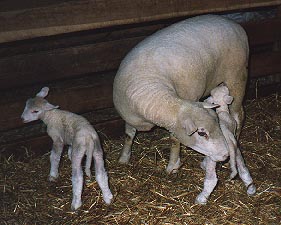
Is the cave under the Basilica of the Nativity the birth place of Jesus?
Edersheim says that Migdal Edar was close to the town, on the road to Jerusalem. A modern topographical map shows the traditional place of the Shepherd’s Field as being about 300 meters from the Basilica of the Nativity on the edge of Bethlehem. The site has a long history as the place of the birth of Christ going back to Origen of Alexander in the 2nd Century who said that Jesus was born in a cave located in Bethlehem. It is entirely possible that this cave or grotto was used to keep sheep and that this is where the tower of the flock was located, but it has not been proved. Other’s have purported the location of the “tower of the flock” in another location in the vicinity which has not been thoroughly excavated. The tower of the flock being a tower built of stones does not exist today and archaeology has not found its ruins. However, based on biblical record, Micah 4:8, and other evidences we must conclude that it was not the stable of an inn where donkeys and other animals were kept was not a tower.
God’s word tells us that Jesus Christ was born in Bethlehem, of Judah in the city of David at a place called the “tower of the flock,” It is not important that we can go today to the exact spot where He was born. And even if we could, would that help us spiritually? I have been to Israel and seen Jerusalem, and many of biblical places, but what I saw has little semblance to what it looked like in Jesus’ day.
For a time I tried to imagine what it looked like during Bible times, but it proved to be a futile effort. As a student of the Bible I also realized that God is not through with this area and this very place the Lord Jesus will return and set up His earthly Kingdom, which He promised to the Jews. It is going to greatly changed again in the future. What really got my spirits lifted and my mind souring was the realization that as a child of God, born again by the Holy Spirit, saved by God’s free gift of grace, through the shed blood of Jesus Christ, I too one day will return to Israel and will abide in His Millennial Kingdom and serve the Lord throughout all eternity. His coming, His life, death, burial and resurrection has assured me of that truth. The significance of His birth is that in God’s time Jesus came exactly as God promised and that as sure as His past promises have been kept, so will His promises for the future. By the way, that was the promise in Micah 4:8. I rejoice and thank God for His sure promises.
Galatians 4:4-5 “But when the fulness of the time was come, God sent forth his Son, made of a woman, made under the law, To redeem them that were under the law, that we might receive the adoption of sons.”

